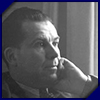JOLIVET Concerto for Flute and String Orchestra. 1 Cello Concerto No. 2. 2 Bassoon Concerto. 3 Piano Concerto. 4 Symphony No. 1. 5 5 Ritual Dances. 5 Rhapsody for Seven 6 1,2,5 André Jolivet, 3 Gennady Rozhdestvensky, 4 Vassily Sinaisky, 6 Valery Polyansky, cond; 1 Alexander Korneyev (fl); 2 Mstislav Rostropovich (vc); 3 Valery Popov (bn); 4 Valery Kastelsky (pn); 1,5 Moscow RSO; 2 French RPO; 3 USSR St SO; 4 Latvian St SO • MELODIYA 10 02215 (70:50; 69:51) 1,5 Live: Moscow 1966
The name of André Jolivet (1905–1974) has been kept alive among collectors by the continued availability of recordings of his flute and trumpet concertos, and recently by a number of issues of his piano, chamber, and choral music. However, compared to his friend and contemporary Olivier Messiaen, his star has faded considerably. His first important works were composed in the mid-1930s (including the Five Ritual Dances , a defining work first written for piano and orchestrated shortly after). His later output was marked by an impressive series of solo concertos including––in addition to the above––the Cello Concerto No. 1, two trumpet concertos, and concertos for violin, harp, and ondes Martenot. Jolivet wrote three symphonies, the First of which (from 1953) is in this collection. (The Third has also been recorded, but surely this is an area where an enterprising company like Naxos might provide us with sparkling new up-to-date versions?)
Jolivet was invited to the USSR to conduct his own music, first in 1966 and then on a few subsequent occasions. Three items in the above program were recorded live in that 1966 concert with the Moscow Radio Symphony Orchestra in the Great Hall of the Moscow Conservatory. I can find no suggestion that Jolivet was an outspoken Communist, nor was he a particularly famous “catch” in Western terms, so the decisive factor must have been Rostropovich. The Frenchman had composed a cello concerto (his Second, for cello and string orchestra) for the great Russian musician, and it was premiered in 1966. Jolivet travelled to Russia to conduct his new work, just as Benjamin Britten did a few years earlier with his Cello Symphony . The performance of the cello concerto in this set was not recorded in Russia, however; it is a studio recording made in Paris three years later.
The repertoire on these two discs gives a good overview of Jolivet’s orchestral music, and it is interesting how Russian some of it sounds. The First Symphony could be a sequel to Prokofiev’s Third––it has the same hysterical edge, certainly in this performance. The Ritual Dances are clearly under the influence of Stravinsky’s Rite of Spring (albeit 20 years after the fact, and in spite of Jolivet’s cranky denial), while the quirky piano parts in the bassoon concerto and sections of the piano concerto are reminiscent of early Shostakovich––possibly because both composers felt the lure of 1920s jazz.
All the Soviet musicians (and that includes the Latvian orchestra) dive into this music with gusto, and if the result is messy here and there, it is undeniably lively and never hangs fire. Flutist Alexander Korneyev brings full tone and a secure line to the best-known piece, the flute concerto; the acerbic quality of its quiet first movement is well captured. The 1976 performance of the bassoon concerto is among the best things here. Valery Popov deftly skates the thin ice between comic and soulful, while Rozhdestvensky in his prime keeps the accompaniment sharp and pointed. The First Symphony tests an orchestra’s mettle in the first and final movements with its tricky cross rhythms and taxing high writing for violins; the composer’s live performance does not always avoid the pitfalls, but the magical textures of the Adagio movement are beautifully balanced. As I said, this recording of the symphony is currently the only game in town and, as far as I can tell, the same applies to the chamber work Rhapsody for Seven , for violin, double bass, clarinet, bassoon, trumpet, trombone, and percussion. This substantial three-movement piece from 1957 in a Neoclassical vein is smartly played by a pick-up group of soloists (Popov again the bassoonist), led by Valery Polyansky, who later went on to conduct a lot of Russian orchestral repertoire for Chandos. Sound quality overall, while variable, is never less than acceptable.
The primary competition is an Erato box set of French performances, most of them under the composer’s baton. Rostropovich’s French performance of the Second Cello Concerto may be found duplicated there; it seems to be the sole recording of the piece. In the other works common to both sets, cooler French heads prevail: Jean-Pierre Rampal plays the flute concerto, Maurice Allard the bassoon concerto, and Jolivet conducts the Orchestre National de l’ORTF in a tauter rendition of the Five Ritual Dances . Elsewhere, a more disciplined performance of the piano concerto (another live concert recording) comes from pianist Pascal Gallet and conductor Jonathan Darlington. Gallet is a Jolivet specialist, having recorded all of Jolivet’s solo piano music; his recording of the concerto is the one to have. (I reviewed it in Fanfare 37:2.) There are several other recordings of the flute concerto. One of the best, partly because the sound is so stunningly lifelike, is by Sarah Louvion on a Farao disc from 2008. Her performance is truly gorgeous (not a word I use lightly), coupled with Jolivet’s chamber piece Chant de Linos and Roussel’s Sérénade . However, as a glimpse of a past era of political tension, when the arts were highly enough regarded that they were commandeered to build bridges, this Melodiya set becomes indispensible. Phillip Scott




